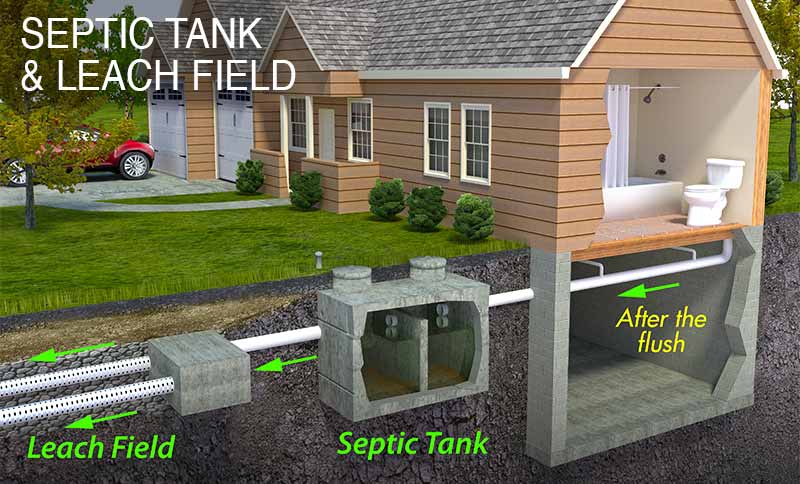As a homeowner, you may be wondering: How does a septic system work anyway? This unseen system performs an incredibly important function for you in your home and is a bank breaking expense to replace. Very different from municipal sewer systems, the septic system is a standalone underground system that handles the wastewater from toilets, showers, laundry, dishwashers, and sinks in a home and then recycles that wastewater into the ground.
With the proper pumping maintenance schedule, you can keep your septic system working properly for years. In order to get your system to last, you must understand how a septic system works and how to take action when needed.
The process begins with the septic tank
To understand how a septic system works, we start with the tank. The inlet drain pipe from your home delivers all the wastewater into an underground airtight container outside called the septic tank. This is the first step of your home’s wastewater filtration system. Just like any liquid mixture, eventually the wastewater will separate into several layers. The solids settle to the bottom of the tank to form the “sludge,” the oil and grease float to the top to create the “scum,” while the middle is filled with a watery mix referred to as the “effluent.”
The wastewater separates as it travels from one side of the tank to the other. The basic “T-shaped” outlet pipe design of the septic tank extends 18 inches into the middle of the tank which will trap the scum at the top and the sludge at the bottom, expelling only the effluent to the next stage of filtration in the septic drain field.
Using nature to help your septic system work
The effluent flows up to outlet-T pipe and out of the septic tank into a distribution box then into a system of perforated plastic pipes buried underground. These pipes are surrounded by stone, and the stone is surrounded by sand which is called a septic drain field (also referred to as a septic leach field). Any bacteria, pathogens, or contaminants are then filtered out of the wastewater by naturally occurring microbes in the sand and soil below the drain field until the freshly cleaned water reaches the groundwater further below the surface.
Keeping a septic drain field clean, unclogged, and flowing freely is the single most crucial component to how a septic system works as an effective filtration system. Over time, build-up in the drain field where the stone and sand meet is common, but managed improperly will clog the natural flow of wastewater, causing backups and ponding in the yard.
What happens to the sludge and the scum?
Taking care of your septic system protects the local drinking water and other water sources from pollution and bacteria. As part of the separation process, the sludge and the scum are left behind in the septic tank. Naturally occurring bacteria will further break down the sludge inside the tank, encouraging more separation.
Even so, the build up of sludge at the bottom and the scum at the top of the septic tank needs to be removed periodically to keep the system functioning properly. Failure to pump the septic tank at the proper intervals can result in damaging the drain field and foul odors… or even worse, sewage ponding in the yard and sewage backup into the home.
It’s easy to keep your septic system working smoothly
Simple proactive pumping maintenance is the most common septic system maintenance method and it’s effective for many years but you’ll find out in our next post that pumping alone is not a lasting solution. Understanding how a septic system fails allows you to know how to prevent that from happening.
An estimated 21 million homes use septic systems to eliminate pollution and recycle wastewater naturally. Septic systems are eco-friendly and use natural soil filtering to eliminate waste and protect local water sources. With proper usage and upkeep, your septic system will work effectively for years.
Do you want to book a septic tank pumping appointment where we optimize your pump schedule based on the waste levels in the tank to save you money? Call Grant Septic Techs at (508) 529-6255 or book online for services in the following areas.
Already having issues with your septic system? This new technology has fixed completely failed clogged and failed septic systems, saving our clients $25,000 on average. If you are interested in prevention, contact us to see if your system qualifies for our Everlasting Septic System — the only solution on the market that is powerful enough to keep your drain field from clogging and eliminate the need for septic tank pumping.

